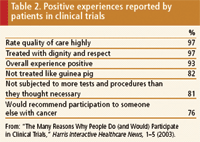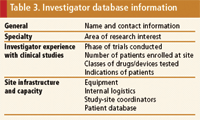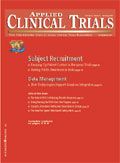Recruitment Strategies: A European Perspective
Europe is moving toward more intense patient contact through a variety of media.
Recruitment of investigators, research sites, and study participants is a constant concern during the course of any sponsored clinical trial. Before a study can even begin, pharmaceutical and CRO clinical research staff must strategically recruit clinical investigators and research sites. This time-consuming, intensive process is a critical first step for a study's ultimate success, but it is becoming more difficult in both the United States and Europe. An increasing number of studies now compete for resources as they seek targeted research subject populations. Fulfilling this need requires the participation of a larger number of centers in clinical trials across all areas of Europe and even in new territories around the world.

Photography: eyewire illustration: paul a. Belci
Once investigators and clinical sites are established, subject recruitment and retention then ultimately determine whether clinical studies adhere to timelines. Although the European public is largely positive about participation in clinical trials, complaints by study subjects in European trials have risen sharply. Guided by the recent EU Clinical Trials Directive, CROs and successful, adaptive European pharmaceutical companies are addressing these issues in a proactive way. They are defining strategies for successful study subject and investigator recruitment, as well as study subject retention, to form a reliable base from which they can complete studies in a timely manner and to the highest quality standards.
Clinical trial recruitment in Europe
For the pharmaceutical industry, clinical drug testing and regulatory approval processes are more complex, more expensive, and more time-consuming than ever. Regulatory agencies—the gatekeepers of the marketplace for new drugs, devices, and therapies—increasingly require larger research subject populations for clinical trials.1 Agencies also require longer periods of treatment and observation before evaluating new drugs for safety and efficacy and, ultimately, approving them.
In the United States, the average drug is tested on more than 4000 study subjects during 37 clinical trials before receiving FDA approval.2 In Europe, drug companies and CROs face similar trends toward tighter regulatory oversight and industry competition for study participants in increasingly large and complex drug development trials.
Depending upon the size of the trial, the condition or disease being examined, and the participant population available, subject recruitment often proves to be a rate-limiting step for many clinical trials. Clinical trial project managers increasingly cite a relative paucity of study subjects for clinical trials worldwide as a major factor in delaying development times of new drugs or treatments in oncology and other therapeutic areas. Availability of study participants of course varies with therapeutic indication and target population. For example, although only about 2% of all cancer patients have ever participated in a clinical trial, some 80% to 90% of pediatric oncology patients are enrolled in studies.3
For companies, any delay in approval for a successful drug can potentially cost millions in sales. In addition to preventing promising novel therapies from reaching future patients, clinical trial delays are estimated to cost companies $1.3 million per day, according to CenterWatch (www.centerwatch.org), an open resource for those interested in participating in clinical trials and for research professionals.
Given that the stakes are so high for drug companies during clinical development, both U.S. and EU governmental regulatory agencies have focused a high degree of scrutiny on the clinical trial process out of concerns over perceived lax procedures, privacy issues, and conflicts of interest. A 2001 report by the Association of Clinical Research Professionals noted a tenfold increase in complaints against clinical test sites, a problem perhaps brought on by the changing landscape of clinical research in both Europe and the United States.4 Nonetheless, the general public seems to understand and support the value and promise of clinical research: A European health survey conducted in 2004 indicated that two-thirds of the general population would be willing to participate in clinical trials.5
Clinical studies are no longer exclusively centralized in teaching and research hospitals. Many clinical trials have been relocated to private practice or small clinical research centers under contract, often spread across the continent in pan-European trials. Companies are also implementing global clinical trials and mining databases in search of physicians who treat patients eligible for trials. Clinical research firms are increasing compensation to doctors as an incentive to actively recruit their eligible patient population. This compensation is at a similar level throughout the European region. Decentralization of clinical trials requires a greater degree of oversight by sponsor companies, more coordinated data management, and more standardized protocols for maintaining participants' privacy and rights.
The most serious bottleneck in clinical trial recruitment comes in much larger Phase II and Phase III trials. In these trials, how participants perceive the potential benefits and risks of clinical trial participation influences their enrollment decisions. Successful recruiting centers typically use information on demographics, such as where a patient population is likely to be receiving medical care. Recruitment is also aided by utilizing information gained from feasibility studies, the experience of individual investigator sites and their subject database, the use of referral sites or primary care outreach activities, and knowledge of the clinical trial environment with respect to competitive studies.
Other recruitment factors include issues in study design that may affect both enrollment and the ability to develop good, productive working relationships between the sponsors or their representatives and the clinical sites to optimize commitment and motivation to the study and recruitment of participants through the project team.
Public opinion of clinical trials in Europe
The European public generally has a favorable view of clinical research. A 2004 survey found that 68% of Europeans would consider joining a clinical trial.5 Nearly two-thirds of those respondents were motivated "to advance medical science." Other most-cited reasons for participation included:
- To earn extra money (58%)
- To help others with the condition (57%)
- To obtain better treatment for their conditions (48%)
- To obtain faster access to treatment for their conditions (34%).
Patients are motivated to participate in clinical studies solely through the influence and encouragement of their treating physicians, particularly in Central and Eastern Europe. Based on the chance to participate in discovering a cure for a life-threatening, debilitating or degenerative illness, participation in clinical trials remains buoyant.

Table 1. Reasons for nonparticipation in clinical trials
Despite the favorable view of clinical trials in Europe, a substantial percentage of eligible participants choose not to enroll in clinical trials. Table 1 lists some of the most frequently cited reasons for refusing to participate in an industry-sponsored oncology clinical trial.6 Although practical issues such as travel distance and expense play a role in subjects' refusal to participate, so do fears of placebo-group placement, the uncertain nature of experimentation, and a lack of faith or trust in medical investigators.
However, when clinical trials are conducted efficiently with careful consideration for keeping participants comfortable, informed, and satisfied with their level of participation, subjects often report satisfaction with their contribution to clinical research. Table 2 lists responses from participants who have successfully completed oncology clinical trials.7

Table 2. Positive experiences reported by patients in clinical trials
Thus, study subjects need to understand what participation in clinical trials can potentially offer them. The following misconceptions should be addressed with a combination of investigator-driven education and a process that ensures protection of quality care and privacy during study participation:
- Receipt of placebo—in some isolated regions in Central and Eastern Europe positive placebo responses are seen in many conditions simply due to intensified medical care.
- Lack of insurance (a problem largely confined to the United States).
- Standard of care (improved in most clinical studies).
Subject education: Recruitment or advertising?
Successful clinical studies pay special attention to educating potential study subjects, both in a general sense of how clinical trials work (education) and specifically how their clinical trial is designed, as well as what is hoped to be gained by their participation (informed consent). Subjects are also told of the risks and benefits, as well as the protection available for them regarding costs, privacy, and rights. In many countries in Europe, the adoption of the European Clinical Trial Directive (Directive 2001/20/EC of the European Parliament and of the Council of the European Union)6 and the European Data Privacy Directive 95/46/EC has increased the information required to be given to potential participants, and this can have a positive effect on enrollment in studies.
In Europe, the shortage of clinical trial subjects, due mainly to competition, has forced drug and research companies to utilize proactive advertising, as well as participant and investigator incentives, to reach potential research subjects who are eligible for clinical drug testing. While the use of mass media outlets, such as radio and television, is not as widespread as in the United States, European companies are increasingly placing information about clinical studies on Internet-based trial registries, which allows patients and research volunteers to search for local clinical trial sites. As in the United States, these Web-based registries have become one of the most rapidly expanding ways to inform and recruit potential study participants.
Some other strategies that have proved effective in the United States to meet clinical trial goals are being implemented in Europe. For example, patients in the United States are encouraged to be active partners in their care by seeking advice from patient organizations, as well as accessing information on clinical trial registries. Potential educational tools and strategies can include specialized publications that explain the goals of the clinical study and the requirements of participation. Such basic material can be augmented by information available on the Internet, from patient organizations, and through the general media. The use of the Internet as a source of information on diseases and clinical studies is increasing rapidly in Europe, as are the number of clinical trial databases.
While the information outlets for reaching participants are growing in Europe, advertising for patients, with a clear emphasis placed on the Web and television, is less acceptable as a means of finding subjects and investigators for clinical studies. The EU Clinical Trials Directive is designed to harmonize clinical research practices for subject recruitment in the EU and align Europe with international standards. In many countries in Europe, regulatory authorities have historically restricted advertising for study subjects. In other countries, there are no clear guidelines for recruitment and advertising, but enrollment in general is hampered by a low awareness of clinical trials among physicians and the general public. Even where advertising is permitted as a means of creating awareness of a disease and encouraging clinical study participation, medical ethics committee approval is always required if information is going directly to patients and volunteers. The EU Clinical Trials Directive is beginning to harmonize the clinical trial regulations throughout Europe, but is only enforced in member states of the European Union. Several countries in Central and Eastern Europe have also implemented similar legislation, as potential EU member states and for consistency.
Screening and case identification
In some therapeutic indications, such as oncology, screening has been shown to be beneficial in the management of certain types of cancer (e.g., cervix, breast), but it is mostly not applicable to identifying subjects for a clinical study. The same is true of acute illnesses, such as acute coronary syndrome, and it is therefore not possible or relevant to advertise for subjects to consider participation in a clinical study. In other conditions, screening is an effective way of targeting patient populations with cryptic subclinical disease.
However, diseases in which screening may be of use in subject recruitment include Type 2 diabetes, hyperlipidaemia, hypertension, osteoporosis, and certain types of infectious diseases. In these cases, advertising for a prescreening phase of a study increases both awareness of, and participation in, clinical studies. In patients already diagnosed with a condition, it is possible to advertise for patients requiring follow-up care who may be interested in participating in a clinical study. Similarly, outreach from the investigator (e.g., by letter) to primary care physicians will encourage the identification of candidates for clinical studies.
Protection of subjects and privacy rights
Subjects should be reassured that their interests, rights, and privacy will be protected during and after participation in a clinical study. Several overlapping, binding provisions, including the EU Clinical Trial Directive and similar legislation in Europe, reflect historical efforts to preserve the rights of clinical trial participants in several ways:
- Initial review of the appropriate central or local ethics committee
- Policies of informed subject consent
- Multinational declarations of participants' general and privacy rights, including the Declaration of Helsinki, Good Clinical Practice standards, and the EU Clinical Trial Directive.
Investigator and study-site staff
A sponsor's objectives in performing trials may be multiple, including:
- Obtaining efficacy and safety data for regulatory submissions
- Gathering product intelligence and experience
- Working with key opinion leaders for marketing purposes.
In Phase II and III studies the ultimate objective must be rapid entry to market and conversion to sales. Investigators may be motivated by several factors, including:
- Scientific interest
- Dissatisfaction with current therapies
- Desire to provide leading-edge care to their patients.
The relationship with the sponsor and CRO will also strongly influence the investigator's motivation and commitment to the study.
Tools to ease the workload of a trial can include providing an on-site study coordinator and good support from the CRO or pharma company. Other research site staff and specialists involved in the management of study subjects can include research nurses, pharmacists, pathologists, and radiotherapists. These clinical personnel are often motivated to participate through the investigator's involvement and are an important target audience for the sponsor and CRO because they may also have a personal interest in the study's scientific interest and medical benefit. They should be included in any plans to raise commitment and maintain motivation, including training, education, and support for attendance at scientific meetings.
Investigator databases
Many pharmaceutical companies and CROs maintain active investigator databases for Europe and the United States. In accordance with local data protection regulations, information is held on investigators with whom companies have experience to facilitate identification of superior sites in terms of quality and subject recruitment. Information typically included in such databases is listed in Table 3.

Table 3. Investigator database information
Pharma companies and CROs also play a critical role in managing recruitment-issue risks. Sponsors have several strategic goals when a study is first initiated to evaluate risk assessment and potential initiatives to ensure the best possible recruitment. These include using intelligence gained from:
- Feasibility studies
- Experience of particular investigator sites
- Referral sites
- Knowledge of the environment with respect to competitive studies.
Placing a study in the best recruiting center, where the appropriate subject population is available, and in a competition-free environment are also critical success factors. Other factors include assessing regulatory pitfalls, issues in study design that may affect recruitment, and, importantly, developing good and productive working relationships with the site to optimize commitment and motivation to the study, as well as recruitment of participants through the study project team.
Site identification and recruitment strategies
Clinical trial managers are employing several methods for site selection, such as detailed feasibility studies to gather more objective data on research site capacity, including staffing levels, location, and surrounding demographics, as well as technology and infrastructure necessary to complete study endpoints. This leads to less reliance on self-reported study populations.
Together with the investigators, the CRO and pharma company have several strategic approaches available to identify suitable sites. Investigators can be encouraged to identify patients through their own databases, prescreen patient populations, and realistically estimate recruitment goals for clinical centers. Moreover, cooperation and collaboration with other clinical professionals, including primary care physicians, can help identify patients and stimulate patient referrals to a particular site. Potential collaborators are many, including:
- Therapeutic networks and working groups
- Academic Medical Centers (AMCs)
- Independent sites
- Site Management Organizations (SMOs)
- Other local CROs
- Phase I units.
When site selection is completed, customized study subject recruitment can be initiated on individual research sites with a focus on individual site recruitment strategies to maximize enrollment and ensure retention. The EU Directive also endorses comprehensive, increased communication materials to establish a general level of participant education about trials that can also aid successful recruitment.
Referral sites/investigator networks. Investigators can be encouraged to use referral sites to recruit subjects, particularly in therapeutic areas in which appropriate study subjects may be difficult to find. Considerations in this approach are:
- Willingness of the referral site to refer
- Logistical issues in terms of subject travel (motivation and reimbursement of travel costs)
- Confidence in the site in terms of medical care
- Potential loss of income
- Loss of patient–physician relationship.
Many physicians are involved in professional research networks, and it is sometimes possible to negotiate the participation of all or part of the network in a clinical study. Many of these networks have become more coordinated in terms of appointing officials, principal physicians, and liaison officers to work with the sponsor. Moreover, they have their own SOPs and organize specific training in GCP and study management. One possible drawback is loss of direct sponsor control and the need for potentially higher grants to cover the administrative burden of the network.
AMCs. Participation of AMCs in clinical studies is declining. Sponsors are prepared to utilize potentially less well-organized academic sites for the involvement of an opinion leader that endorses their drug. Most academic centers are becoming more efficient and have formed networks of key opinion leader investigators on a national or international basis to maintain a competitive edge.
Independent sites. Although slow to develop compared with the United States, the number of independent clinical research sites is growing in Europe. These independent sites have established an infrastructure to enable rapid recruitment of subjects and quicker reporting of data, ensuring compliance with regulatory requirements and strict QA review.
SMOs. SMOs often have their own subject clinical trial database developed through working with referring investigators and physician networks, which facilitates recruitment of clinical study subjects. Additionally, SMOs typically have experience in clinical studies. SMO models include:
- Full-time facilities and in-house staff
- Contract structures in which physicians manage clinical trials within their own practice
- Brokering services
- Investigator-owned networks.
Most SMOs are multitherapeutic, but several are niche providers. Network types provided by SMOs include: hospital, general practice, and nursing home/long-term care; workforce and occupational health; and specialists and paramedical health service.
This resource is rapidly expanding in both the United States and Europe. Most estimates predict that the SMO sector will expand its market share in the next five years, particularly because the use of CROs has not led to any significant reduction in drug development time.
Phase I units. Phase I units provide a source of patients and healthy volunteers in areas in which companies have limited expertise. Typical opportunities lie in vaccine research and Phase I components of large development programs in which it may be advantageous to the client to place the entire program with one provider to ensure cost efficiencies and continuity of expertise. Many European companies are identifying strategically important units to conduct Phase I work.
Conclusions
Europe is adopting more proactive and widespread measures targeted at participant education and recruitment using direct communication through various forms of media. This is guided by the EU Clinical Trials Directive and similar legislation, including Data Protection Acts that define elements of subject protection/privacy and the level of communication required. While planning study protocols, trial managers are using a number of strategies to boost participation, recruitment, and retention of subjects and clinical investigators and their staff in the study. Many forms of communication are available, including patient group communications (newsletters/Web sites), study-specific newsletters and Web sites, newspaper and magazine editorials, and articles in peer-reviewed health care journals. All of these outlets can be utilized to a greater or lesser degree to dovetail with recruitment goals and study design. These changes in subject recruitment strategies will help to harmonize recruitment efforts across Europe, making it even more competitive in the rapidly growing global clinical trials market.
Philippa Smit-Marshall, MBChB, BSc, MFPM, is executive director, medical & scientific affairs Europe with PharmaNet, Storkstraat 18-20, 3833 LB Leusden, The Netherlands, 31-33-4326200, fax 31-33-432-6201, email: psmit-marshall@pharmanet.com.
References
1. J.A. DiMasi, R.W. Hansen, H.G. Grabowski, "The Price of Innovation: New Estimates of Drug Development Costs," J Health Econ, 22, 151–185 (2003).
2. J.A. DiMasi and C. Paquette, "The Economics of Follow-on Drug Research and Development: Trends in Entry Rates and the Timing of Development," Pharmacoeconomics, 22, 1–14 (2004).
3. N.C. Institute. Cancer Progress Report 2003 Update: Treatment.
4. "Clinical Research in Transition," Assoc Clin Res Prof, 2001.
5. BBK Healthcare, The 2004 International Will & Why Survey.
6. "Misconceptions and Lack of Awareness Greatly Reduce Recruitment for Cancer Clinical Trials," Harris Interactive Healthcare News, 1–3 (2001).
7. "The Many Reasons Why People Do (and Would) Participate in Clinical Trials," Harris Interactive Healthcare News, 1–5 (2003).
Improving Relationships and Diversifying the Site Selection Process
April 17th 2025In this episode of the Applied Clinical Trials Podcast, Liz Beatty, co-founder and chief strategy officer, Inato, discusses a number of topics around site engagement including community-based sites, the role of technology in improving site/sponsor relationships, how increased operational costs are impacting the industry, and more.
SCOPE Summit 2025: Enhancing the Patient Experience Through Site Centricity
February 12th 2025In an interview with ACT senior editor Andy Studna at SCOPE Summit, Ashley Davidson, vice president, product lead - sponsor tech strategy, Advarra, highlights the need for more site-centric approaches in study startup.
